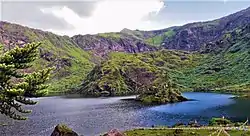Upper Siang district
Upper Siang (Pron:/ˈsjæŋ or ˈsɪæŋ/) is an administrative district in the state of Arunachal Pradesh in India. It is the fourth least populous district in the country (out of 640).[2]
Upper Siang district | |
|---|---|
District of Arunachal Pradesh | |
 Tsitapuri lake | |
 Location of Upper Siang district in Arunachal Pradesh | |
| Country | |
| State | Arunachal Pradesh |
| Headquarters | Yingkiong |
| Area | |
| • Total | 6,188 km2 (2,389 sq mi) |
| Population (2011) | |
| • Total | 35,320[1] |
| Demographics | |
| • Literacy | 60.0%[1] |
| • Sex ratio | 891[1] |
| Time zone | UTC+05:30 (IST) |
| Website | uppersiang |
History
The majority of the people are of the Adi tribe while the Memba, Khamba Idu Mishmi tribe also exists there (Idu Mishmi has not existed there). Part of the area was controlled by the Tibetan Kingdom of Powo when streams of Tibetan pilgrims searching for one of the 'hidden lands' or beyul (Standard Tibetan: sbas-yul) referred to in the prophecies of Guru Rinpoche in the East Himalayas from the mid-seventeenth century came south over the Doshong La pass, to seek the particular location of one of these earthly paradises called Padma bkod (written variously Pema köd, Pemakö and Pemako), literally 'Lotus Array' in the region. The region became administered by British India with the Simla Accord of 1914 and the demarcation of the McMahon Line, though China considers it part of South Tibet.
There are 7 plants in the district. The district was formed in 1999 when it was split from East Siang district.[3]
Geography
The district headquarters are located at Yingkiong. Upper Siang district occupies an area of 6,118 square kilometres (2,362 sq mi),[4]
The district is the location of the massive Upper Siang Hydroelectric Project.
Transport
The 2,000-kilometre-long (1,200 mi) proposed Mago-Thingbu to Vijaynagar Arunachal Pradesh Frontier Highway along the McMahon Line,[5][6][7][8] (will intersect with the proposed East-West Industrial Corridor Highway) and will pass through this district, alignment map of which can be seen here and here.[9]
Divisions
There are two Arunachal Pradesh Legislative Assembly constituencies in this district: Tuting-Yingkiong and Mariyang-Geku. Both are part of Arunachal East Lok Sabha constituency.[10]
Demographics
| Year | Pop. | ±% p.a. |
|---|---|---|
| 1961 | 9,790 | — |
| 1971 | 21,330 | +8.10% |
| 1981 | 21,125 | −0.10% |
| 1991 | 27,779 | +2.78% |
| 2001 | 33,363 | +1.85% |
| 2011 | 35,320 | +0.57% |
| source:[11] | ||
According to the 2011 census Upper Siang district has a population of 35,320,[12] roughly equal to the nation of Liechtenstein.[13] This gives it a ranking of 637th in India (out of a total of 640).[12] The district has a population density of 5 inhabitants per square kilometre (13/sq mi) .[12] Its population growth rate over the decade 2001–2011 was 5.77%.[12] Upper Siang has a sex ratio of 891 females for every 1000 males,[12] and a literacy rate of 59.94%.[12]
Various tribal groups of the Adi people and the Memba tribe live in the district. The Adi follow generally follows Donyi-Polo, and the Memba are followers of Tibetan Buddhism.
Languages
Languages spoken include Adi, a Sino-Tibetan tongue with approximately 140 000 speakers, and Tshangla and Khampa Tibetan languages both belonging to the Bodish group, these languages are written in both the Tibetan and Latin scripts.[14]
Flora and fauna
In 1986 Upper Siang district became home to Mouling National Park, which has an area of 483 km2 (186.5 sq mi).[15] A new mammal to science, Mebo giant flying squirrel (Petaurista siangensis) has been reported from this district[16]
References
- "District Census 2011". Census2011.co.in.
- "District Census 2011". Census2011.co.in. 2011. Retrieved 30 September 2011.
- Law, Gwillim (25 September 2011). "Districts of India". Statoids. Retrieved 11 October 2011.
- Srivastava, Dayawanti; et al., eds. (2010). "States and Union Territories: Arunachal Pradesh: Government". India 2010: A Reference Annual (54th ed.). New Delhi, India: Additional Director General, Publications Division, Ministry of Information and Broadcasting (India), Government of India. p. 1113. ISBN 978-81-230-1617-7.
- Dipak Kumar Dash. "Top officials to meet to expedite road building along China border". The Times of India. Retrieved 27 October 2014.
- "Narendra Modi government to provide funds for restoration of damaged highways". www.dnaindia.com. Retrieved 27 October 2014.
- "Indian Government Plans Highway Along Disputed China Border". Ankit Panda. thediplomat.com. Retrieved 27 October 2014.
- "Govt planning road along McMohan line in Arunachal Pradesh: Kiren Rijiju". Live Mint. Retrieved 26 October 2014.
- "China warns India against paving road in Arunachal". Ajay Banerjee. tribuneindia.com. Retrieved 26 October 2014.
- "Assembly Constituencies allocation w.r.t District and Parliamentary Constituencies". Chief Electoral Officer, Arunachal Pradesh website. Archived from the original on 13 August 2011. Retrieved 21 March 2011.
- Decadal Variation In Population Since 1901
- "District Census 2011". Census2011.co.in. 2011. Retrieved 30 September 2011.
- US Directorate of Intelligence. "Country Comparison:Population". Retrieved 1 October 2011.
212 Liechtenstein 35,236 July 2011 est.
- M. Paul Lewis, ed. (2009). "Adi: A language of India". Ethnologue: Languages of the World (16th ed.). Dallas, Texas: SIL International. Retrieved 28 September 2011.
- Indian Ministry of Forests and Environment. "Protected areas: Arunachal Pradesh". Archived from the original on 23 August 2011. Retrieved 25 September 2011.
- Choudhury, A.U. (2013). Description of a new species of giant flying squirrel of the genus Petaurista Link, 1795 from Siang Basin, Arunachal Pradesh in North East India. The NL & Journal of the Rhino Foundation for nat. in NE India 9: 30–38, plates.